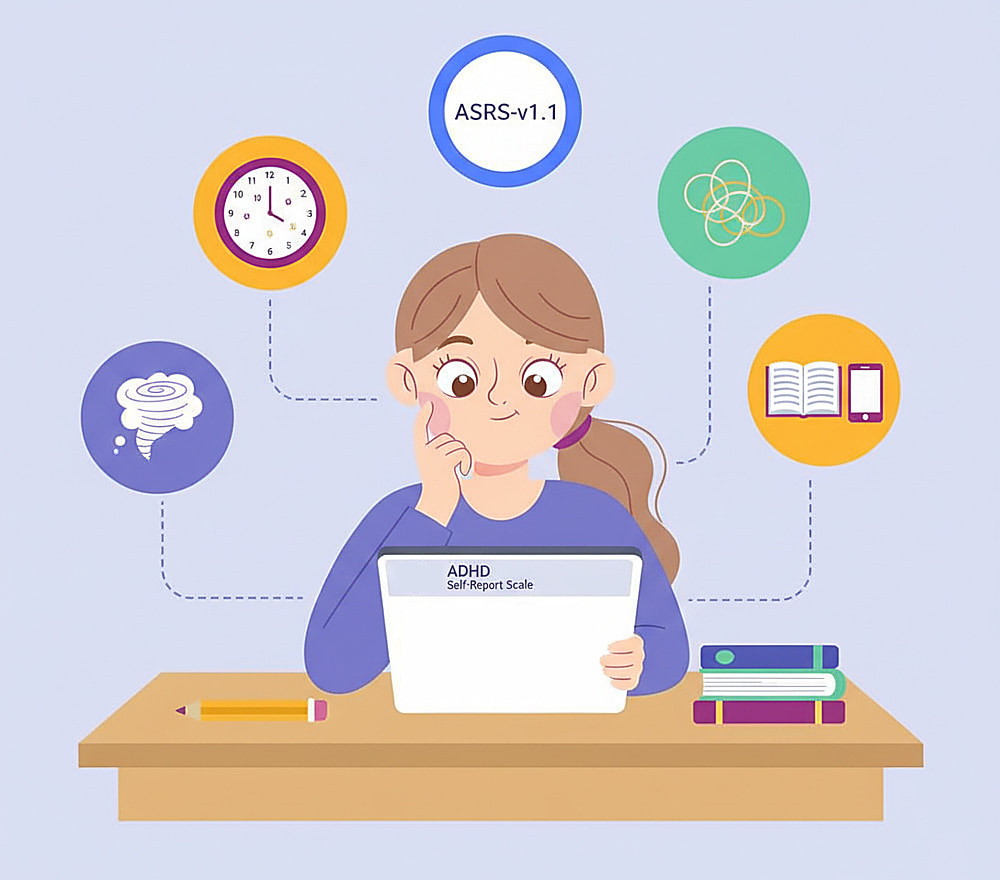Learn About the ADHD Self-Report Scale and Its Purpose

Take ASRS Assessment for ADHD
Get StartedThe ADHD Self-Report Scale, also known as the adult ADHD self-report scale ASRS symptom checklist, is a highly appreciated tool within the medical and psychological community. This valuable self-assessment questionnaire, designed to assist both adults and children, is instrumental in detecting manifestations of Attention Deficit Hyperactivity Disorder (ADHD). It empowers individuals to gain a deeper understanding of their symptoms and behaviors, thereby enabling more meaningful and informed discussions with healthcare providers. The checklist, with its detailed insights, isn't just a tool, but a roadmap, guiding the way towards effective treatment and management strategies for ADHD.
ADHD Self-Report Scale: What It Is and How It Works
The adult version of the self-report scale, known as the adult ADHD self-report scale ASRS-v1.1 symptom checklist, allows individuals to self-evaluate their symptoms and share this data with healthcare professionals. This checklist aids in identifying the impact of symptoms on daily life. Assessing the frequency and severity of symptoms through a structured questionnaire provides a comprehensive picture of how ADHD affects various aspects of an adult's life.
Structured similarly, the childhood ADHD symptoms scale self-report offers a parallel framework for understanding symptoms in younger individuals. This child-centric scale helps in recognizing patterns that may have persisted unchecked, improving early intervention strategies.
Pros of Using the ADHD Self-Report Scale
The use of the ADHD self-report scale symptom checklist provides numerous benefits. Primarily, it empowers individuals by offering a clearer understanding of their condition. The benefits of incorporating the adult ADHD self-report scale symptom checklist into a patient's routine are manifold. Not only does this tool heighten self-awareness, but it also paves the way for more productive consultations with healthcare providers. With a personalized treatment plan crafted based on the checklist's results, patients can experience a more tailored approach to managing their symptoms. Moreover, this checklist encourages open, transparent dialogue between patients and doctors, ensuring that everyone involved is on the same page when it comes to managing ADHD symptoms effectively.
- Enhances self-awareness about ADHD symptoms
- Facilitates better communication with healthcare professionals
- Assists in tracking symptom progress over time
- Supports development of personalized treatment strategies
How the ADHD Self-Report Scale Works
Typically, the adult ADHD self-report scale symptom checklist asks respondents to rate how frequently they experience specific symptoms associated with ADHD. Responses are usually gathered on a Likert scale, allowing for a nuanced understanding of symptom severity. This methodology not only identifies symptoms but also highlights their impact on everyday functions.
This approach extends to the ASRS ADHD scale, providing a reliable metric for gauging symptoms in adults. Scores are then assessed using a scoring guide to determine the likelihood of ADHD, offering a pathway to formal diagnosis and treatment.
Scoring and Interpretation
The adult ADHD self-report scale ASRS-v1.1 scoring system, for instance, categorizes symptoms in terms of frequency and impact. The use of a structured system, such as the ADHD self-report scale symptom checklist, is incredibly beneficial in healthcare settings. By interpreting the scoring ranges on this comprehensive tool, professionals are able to accurately evaluate a person's position on the spectrum of ADHD symptoms. This ensures a more targeted and effective approach to managing and treating ADHD.
Conversely, the childhood ADHD symptoms scale self-report scoring adopts a similar method tailored for younger individuals, considering both developmental milestones and age-specific behaviors that reach beyond mere symptom identification.
| Section | Description |
|---|---|
| Frequency | How often are symptoms reported |
| Impact | The effect of symptoms on daily activities |
| Severity | Intensity of the symptoms experienced |
Frequently Asked Questions
- What age group is the ADHD Self-Report Scale designed for?
The scoring ADHD self-report scale has both adult and child versions, each tailored to the specific age group for accurate symptom assessment.
- How is the ADHD Self-Report Scale administered?
It is typically a self-administered questionnaire. However, guidance from professionals improves interpretation, especially for the adult ADHD self-report scale ASRS symptom checklist.
- Can the ADHD Self-Report Scale replace a professional diagnosis?
No. The scale is a screening tool that provides insights but must be used alongside professional diagnostic evaluations.
- What should be done after completing the ADHD Self-Report Scale?
Results should be shared with a healthcare provider to discuss next steps, including diagnosis and treatment planning based on the ADHD self-report scale symptom checklist.
- Is it possible to track progress over time with the ADHD Self-Report Scale?
Yes. Regular use of the scale helps track ADHD symptoms over time, supporting better management and awareness of its impact.
